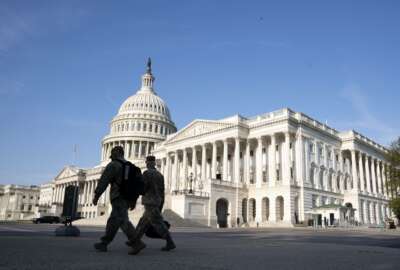

Executive Vice President for Policy at the Professional Services Council, Stephanie Kostro spoke to Federal Drive with Tom Temin.
Best listening experience is on Chrome, Firefox or Safari. Subscribe to Federal Drive’s daily audio interviews on Apple Podcasts or PodcastOne.
The White House hasn’t released all of the details on its 2022 budget request, but enough is out so that federal contractors are getting the picture. Joining with reaction to this and a couple of other recent developments, the Executive Vice President for Policy at the Professional Services Council, Stephanie Kostro spoke to Federal Drive with Tom Temin.
Interview transcript:
Tom Temin: Ms. Kostro, good to have you back.
Stephanie Kostro: Good morning, and thank you for having me.
Tom Temin: And I guess the lack of detail is what’s most noticeable to you in the budget.
Stephanie Kostro: So Tom, one of the remarkable things is that this is a $6 trillion budget in total spending for the next fiscal year. And it’s the most expansive growth in the federal government, reportedly, since World War Two. That said, I’ve been looking at budgets now for 15-20 years and I’m also astounded by the lack of detail, and I’m looking forward to several of the hearings coming up on the Hill where federal officials need to defend this budget. I’m looking forward to giving a lot more detail than what is presently in the documentation.
Tom Temin: Yeah, what are some of the details that you have not been able to find that you would normally look for first?
Stephanie Kostro: So I come from a defense background, and so I always check out the defense budget justification documents first and foremost. And in them, I noticed there is a drop in procurement. Let’s take the Navy, for example, there is a procurement drop of just under 6%, and growth in all of the other accounts, whether it’s operations and maintenance, military personnel, infrastructure, research and development. But unpacking that, and finding out exactly where the money is going, is sort of a black hole for me. These are budget documents that I’ve been looking, again, 15-20 years, and I kind of know my way around navigating them. And where I would expect to find detail, I’m not finding detail. And that imprecision may not be unexpected. This is a budget that’s been delayed, there’s been a lot of discussion behind closed doors within the federal government. But the fact that they’ve released this, I’m hopeful that we will get more information as people’s feet are held to the fire, proverbially, so that we can get more detail.
Tom Temin: And of course, Navy procurement is probably more indirect to Professional Services Council members than say, cybersecurity, information technology spending. And I guess knowing that there is a rise in operations and maintenance budgets, that tends to be toward the professional services too in some cases.
Stephanie Kostro: It does. And that’s why when we look at increased operations, maintenance costs for research and development, testing evaluation accounts, that’s really where our 400 plus member companies really are unpacking this budget, and finding that there are increases but not being able to directly track them is a little bit frustrating for contractors at this point.
Tom Temin: So they really can’t do the planning they would normally do to try to have an attack strategy for this budget.
Stephanie Kostro: 100%. Businesses really like consistency, they like predictability, so they can plan to it. And so when budgets like this drop, and it’s $6 trillion, that number alone is sort of exhilarating to think about, but without being able to unpack it. How do you plan for that, and that is something that every single contractor in the DC area and beyond is looking at
Tom Temin: Right. A lot of those elements of that 6 trillion are beyond what we normally think of as the discretionary budget of 1.5 something ,1.52 I think it was, trillion, but also they have a lot of proposals beyond the non discretionary traditional spending of Medicare, Medicaid, Social Security — there’s this huge chunk that is more policy standpoint, than real action standpoint.
Stephanie Kostro: That’s true. If you look at what comprises the 6 trillion it is the discretionary budget, and we got the skinny budget, now two months ago almost, that was about 1.5 trillion. But you’ve got a $2 trillion American Jobs Plan Act, and our contractors, the contracting community is looking at infrastructure, roads, bridges, elder care, broadband., so that’s the tech piece that you referenced earlier. And then there’s also the $1.8 trillion American Families Plan Act which talks about higher education and extended child care and health care. That’s all very interesting as well. But when you look at what is provided in the discretionary budget, and what might be available in the out years, and by that I mean beyond fiscal year 22, it’s a little bit again of a black box and a little bit fuzzy, and I’m looking forward to hearing what people have to say about that.
Tom Temin: We’re speaking with Stephanie Kostro, executive vice president for policy at the Professional Services Council. And I want to bring in a different topic here because this is something that people in services can really glom on to, and that is the release of the solicitation for CIO-SP4 from the NIH’s procurement operation NITAAC. This is a big deal, isn’t it?
Stephanie Kostro: It is. And you mentioned tech earlier and we had the cybersecurity executive order come out just about two-three weeks ago, and trying to track in the budget where that cybersecurity/information technology money is going. But in the near term, this is a long anticipated long awaited much ballyhooed, for lack of a better word, I’m using my old fashioned words here, CIO-SP4, it is a $50 billion RFP that was released last week for a broad range of IT services. It was delayed reportedly because of clearance from the Small Business Administration. And so looking at it going forward, how will bidders respond, the deadline is June 28, looking at several factors — help IT capability, management approach, past performance price. And that is just to get past phase one, and moving forward into being considered a real contender for this large RFP.
Tom Temin: Alright. And there is related to both of these things, the government needs the money that it’s going to have to borrow to do any of this, which is most of the money that it’s spending. And so the debt ceiling reset two months away now, and golly, there doesn’t seem to be a lot of thought about that right now on the Hill.
Stephanie Kostro: This is an area of surprise for both our president and CEO David Berteau and the rest of the PSC staff. The debt needs to reset on August 1, and there’s been very little chatter about how our government plans to get past that. Now, if you asked what happens on August 1, that’s the date where we start to run the risk of a national default on America’s debts. And that event would have unknown but likely catastrophic impacts. The Department of the Treasury has some extraordinary measures. And they’re extraordinary in that they get called into play in situations like this. Normally, they’d have a two-three-four month runway after that date. Because of spending and because of the amount of money we’ve put towards COVID and other national emergencies, they may have four to six weeks, not three to four months. And that is a huge driving factor, or should be, in having congressional folks talk to each other about what they’re going to do for the debt.
Tom Temin: Alright. So something to keep in what you might call the tickler folder, using another old fashioned word. But yeah, that one’s not so much a tickler file as a bite if they don’t do something about that by August 1.
Stephanie Kostro: Seriously, August 1 is one of those dates where, if we could also get a budget deal for fiscal years 22 and 23, but for this point, I’m just happy if they would reset the debt ceiling so that we don’t have to incur everything that comes with defaulting on a national debt.
Tom Temin: Yeah, maybe they could set it like the cicadas so that they don’t have to worry about it for the next 17 years.
Stephanie Kostro: It could disappear underground for 17 years.
Tom Temin: And finally, PSC is looking at the issue of federally funded research and development centers, FFRDCs, and that they are being used perhaps for projects that are best done by the private sector.
Stephanie Kostro: So FFRDCs were created and are often used for basic research and other issues that the private sector can’t help with. But in recent years, it appears that much more work has been sent to FFRDCs that could be done more efficiently and perhaps more effectively by the private sector. And so this is an area we’re watching closely. There was a requirement in the FY 21 DoD appropriations, a section of the omnibus bill that was passed, that asked for a report. And now that the new appropriations cycle is starting, it’s important to have that information before we start wondering whether we should increase reliance on FFRDCs.
Tom Temin: Alright, lots to think about these days. It’s a turbulent time. Stephanie Kostro is executive vice president for policy at the Professional Services Council. Thanks so much.
Stephanie Kostro: Thank you.
Copyright © 2025 Federal News Network. All rights reserved. This website is not intended for users located within the European Economic Area.
Tom Temin is host of the Federal Drive and has been providing insight on federal technology and management issues for more than 30 years.
Follow @tteminWFED



